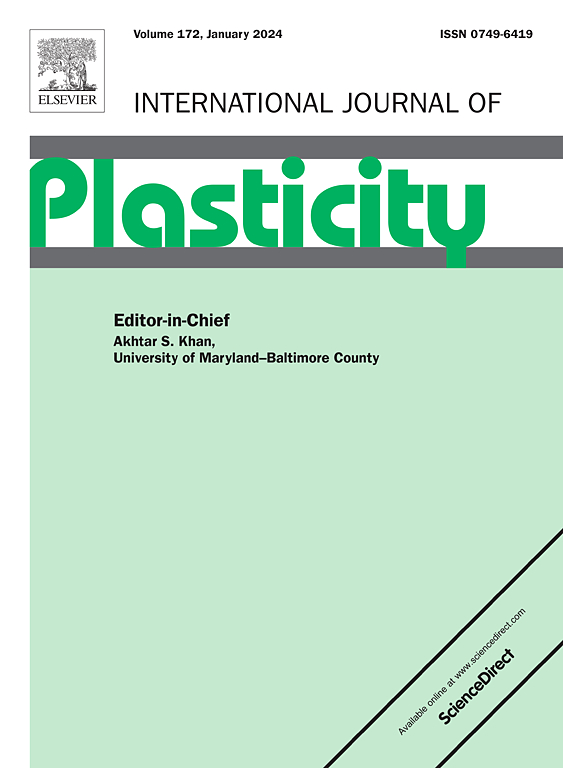Influence of microstructural heterogeneity on the plastic strain localisation in selective laser melted 18Ni-300 maraging steel
IF 12.8
1区 材料科学
Q1 ENGINEERING, MECHANICAL
引用次数: 0
Abstract
Plastic strain localisation in selective laser melted (SLM) 18Ni-300 maraging steel under uniaxial tensile loading was characterised via electron backscatter diffraction (EBSD), in-situ tensile experiments, and digital image correlation under the scanning electron microscope (a methodology known as SEM-DIC). Two sample conditions were investigated, namely the as-built (AB) and solution-aging treatment (SAT) conditions. During plastic deformation, the large quantity of equiaxed grains in the AB sample led to grain boundary strengthening, while the presence of densely distributed Ni-based intermetallics in the SAT sample led to strain hardening. SEM-DIC analysis revealed that plastic strain localisation in AB and SAT samples exhibited significant heterogeneity and was highly localised. Slip was identified as the main deformation mechanism for both AB and SAT samples, and preferentially occurred in grains with increased internal misorientation. Five or more independent slip systems were active in the investigated grains of AB and SAT samples during plastic deformation. The combined kinematics of the active slip systems were reflected in the in-plane deformation behaviour for the investigated grains (i.e. G2 in AB sample and G8 in SAT sample). The findings of the present work would provide fundamental insights into tailoring the material’s microstructure for optimised performance in industrial applications.


显微组织非均匀性对激光熔化18Ni-300马氏体时效钢塑性应变局部化的影响
通过电子背散射衍射(EBSD)、原位拉伸实验和扫描电子显微镜下的数字图像相关(一种称为SEM-DIC的方法),表征了选择性激光熔化(SLM) 18Ni-300马氏体时效钢在单轴拉伸载荷下的塑性应变局部化。研究了两种样品条件,即原位处理(AB)和固溶时效处理(SAT)条件。在塑性变形过程中,AB试样中大量的等轴晶导致晶界强化,而SAT试样中密集分布的ni基金属间化合物导致应变硬化。SEM-DIC分析显示,AB和SAT样品的塑性应变局部化表现出显著的异质性和高度局域化。滑移是AB和SAT试样的主要变形机制,滑移优先发生在内部取向错误增加的晶粒中。在塑性变形过程中,AB和SAT试样中存在5个或更多独立的滑移系统。主动滑移系统的联合运动学反映在所研究晶粒的面内变形行为中(即AB样品中的G2和SAT样品中的G8)。本工作的发现将为定制材料的微观结构以优化工业应用中的性能提供基本见解。
本文章由计算机程序翻译,如有差异,请以英文原文为准。
求助全文
约1分钟内获得全文
求助全文
来源期刊

International Journal of Plasticity
工程技术-材料科学:综合
CiteScore
15.30
自引率
26.50%
发文量
256
审稿时长
46 days
期刊介绍:
International Journal of Plasticity aims to present original research encompassing all facets of plastic deformation, damage, and fracture behavior in both isotropic and anisotropic solids. This includes exploring the thermodynamics of plasticity and fracture, continuum theory, and macroscopic as well as microscopic phenomena.
Topics of interest span the plastic behavior of single crystals and polycrystalline metals, ceramics, rocks, soils, composites, nanocrystalline and microelectronics materials, shape memory alloys, ferroelectric ceramics, thin films, and polymers. Additionally, the journal covers plasticity aspects of failure and fracture mechanics. Contributions involving significant experimental, numerical, or theoretical advancements that enhance the understanding of the plastic behavior of solids are particularly valued. Papers addressing the modeling of finite nonlinear elastic deformation, bearing similarities to the modeling of plastic deformation, are also welcomed.
 求助内容:
求助内容: 应助结果提醒方式:
应助结果提醒方式:


